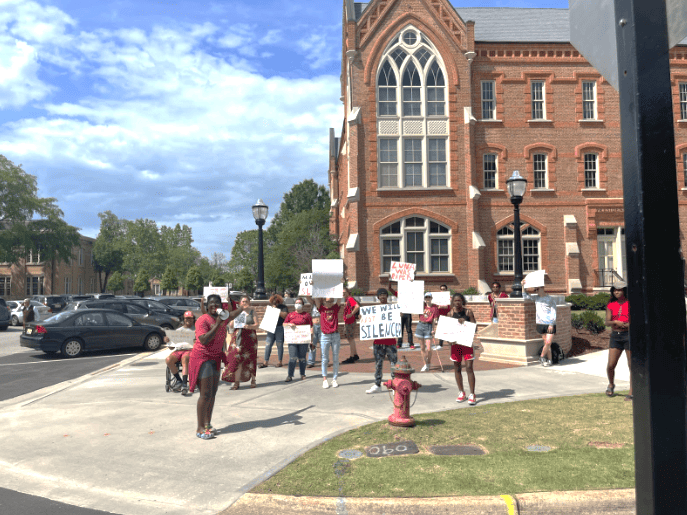Students protest monument’s use of bricks made by slaves
May 4, 2022
Students gathered at the Presidents Hall Commemorative Wall on Friday to protest the upcoming installation of plaques on top of the wall’s bricks that protesters alleged were made by slaves.
The plaques will honor former UA presidents, some of whom were slave owners. Protestors said the bricks in question were used to build Old Bryce Hospital.
According to “African American Patients in Tuscaloosa’s Mental Hospitals,” a piece in Hilary Green’s “African American Memory,” Bryce Hospital was built by slaves. Green is an associate professor of history and co-program director of the University’s African American studies program.
The Old Bryce Hospital campus is being turned into a new UA welcome center and an instruction and performance space for the dance and theater departments.
The plaques will be placed on the Presidents Hall Commemorative Wall, which is in front of President’s Hall. Construction on the wall began in Dec. 2021 and was slated for completion in Feb. 2022 according to the project’s page on the Building Bama website. The plaques have not yet been added.
“The project will provide a space to celebrate past presidents of the University, as well as provide a gathering and seating space for students and visitors,” the website reads.
Erin Chatman, a junior majoring in African American studies, organized and led the protest, which lasted from 1 p.m. to 4 p.m.
“These bricks were handmade by enslaved people,” Chatman says. “We have the bricks of the enslaved people underneath the bricks that will have the presidents’ name on it. And that’s telling me that the presidents continue to oppress these people even beyond the grave.”
Protestors held signs with messages such as, “Don’t Walk Away. Wake Up!,” “These Bricks Were Made by Slaves,” “Slaveholders Don’t Deserve Monuments” and “Blood on Your Campus, Blood on Your Hands.” One sign listed the names of slaves rented and owned by the University and its presidents, and another displayed “Luna Was Raped.”
“We learned vaguely about [Luna] in Dr. [Hilary] Green’s class,” says Chatman. “She was enslaved by a faculty member…who was working under the Manly administration.”
Hilary Green said this class is The Education of Southern Blacks.
“[The Education of Southern Blacks] is a historic course at UA,” said Hilary Green “[it is] the history of African American education, from slavery to the present.”
“Manly also owned a lot of slaves,” Chatman says. “Luna was pimped out, technically, by another enslaved person. And she was raped almost every day by UA students.”
Manly served as the University’s second president from 1837 to 1855. He was a slave owner and pro-slavery lobbyist who served as chaplain to the Alabama Secession Convention and first chaplain for the Confederacy.
Presidents Hall was formerly named Manly Hall until November 2020, when the UA Board of Trustees renamed the building.
“Dr. Manly was also a major proponent of slavery,” A resolution released by the UA Board of Trustees read. “As an educational and religious leader, he proclaimed for four decades that slavery was ordained by God. His pronouncements helped build a religious justification for slavery and to harden white Southerners’ determination to defend the institution … As a substantial slaveholder himself, he used flogging, sometimes administered by his own hands, to punish enslaved people he owned and those owned by the University.”
The construction crew who built the monument told Hilary Green that the bricks used came from Bryce Hospital.
“It was confirmed to me, but also Dr. Sharony Green, when we asked the construction crew where they got the brick,” Hilary Green said. “It was communicated to us, as well as the students as they passed by … because of the history of Bryce as well as other UA buildings at the time, we all knew from their records that [slaves] would have made those bricks.”
The University would have most likely rented the slaves from contractors according to Hilary Green.
“[Slaves] would have been rented out to the university and hired out that way through contracting,” Hilary Green said. “They would not have been owned directly by UA or the faculty, but by employee firms and companies that used enslaved labor.”
Myranda Bell and Faith Moultrie, both juniors majoring in African American studies, also helped organize the event.
“We’re protesting the President’s monument that is currently being built,” Bell said. “We’re asking for the enslaved people’s names to also be present on this monument…If you don’t make a change, if you don’t even say anything … you’re still a part of the problem. It tells us that we don’t belong here. It tells us that we should know our place as enslaved people.”
“The history of slaves and Black people is so deeply rooted in the history of the campus that you can’t ignore it for much longer,” Moultrie said. “It’s gonna come out to light. They should just acknowledge it … especially if [they] want to be known as a school that is inclusive.”
Jeremy Boyd, a senior majoring in African American studies, said he is angry and hurt by the way Black students are treated on campus.
“[The University] profits off of Black labor and Black image,” Boyd said. [They’re] portraying this idea of a diverse campus, when in reality, any Black person on campus can tell you that something is not quite right. You can literally just google ‘UA racism’ and so much stuff will come up.”
Zoe Rose Pallas, a master’s student, said more non-Black students should protest alongside and support Black students on a campus that she said still exhibits racism.
“Schools and institutions across the country, across the world, particularly in the South, have [been] content ignoring the ills of the past, which only allows them to continue to fester in the present,” Pallas said. “There’s still issues with racism on campus. I want to ask my colleagues, friends and white people on campus, non-Black people on campus, to show up for these events.”








